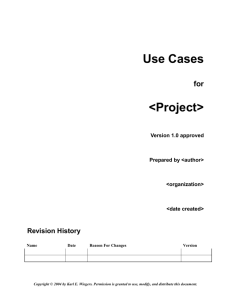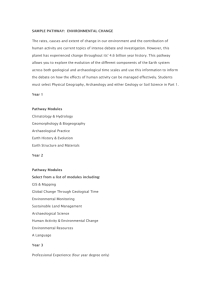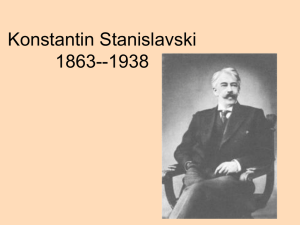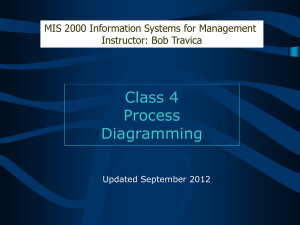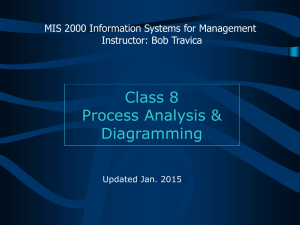A Use Case
advertisement
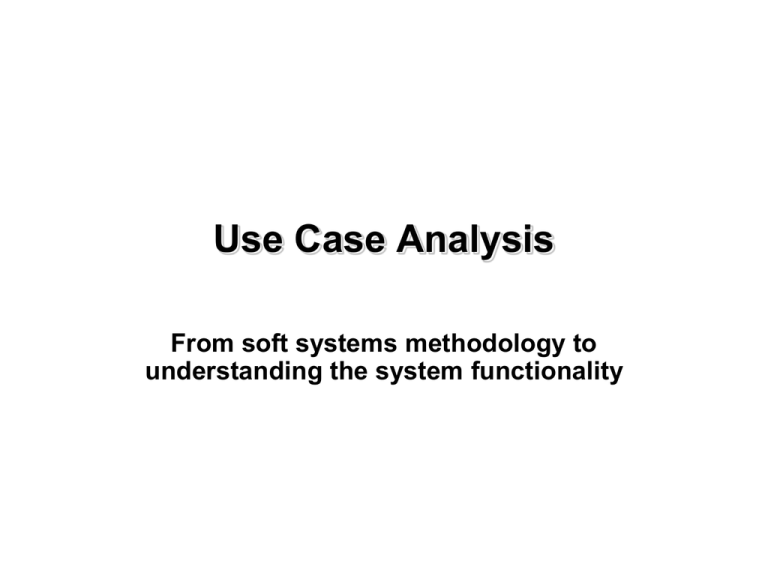
Use Case Analysis From soft systems methodology to understanding the system functionality The Vision SSM Models Databases Use Cases Activity Models Programs Object Models Dynamic Models Business Computing Beginnings of a Method Soft Systems Model Use Case Models • Consist of – Use Cases – Actors – Relationships between Actors and Use Cases What is a Use Case? Formal definition “A Use Case is a sequence of transactions performed by a system that yields a measurable result of values for an actor” A Use Case: • is a meaningful piece of system functionality • models a dialogue between a user and the system Note - The user can be another system • is more than a simple transaction (e.g. enter customer address) We draw a use case as: A Use Case Examples of Use Cases • Print Invoice • Correct Invoice • Chase Payment • Register Bad Debt What is an Actor? • Anyone or any thing that uses or interfaces with the system, such as: – customer – credit controller – EPOS system – Bank system We draw actors as: An Actor Actors and Use Cases • An Actor may use many Use Cases • A Use Case may interface with many Actors • We draw a simple line to indicate interaction Relationships between actors and use cases An Actor A Use Case Arrows indicate who initiates interaction An Actor A Use Case Sometimes the use case initiates interaction Use Cases can be related • One Use Case may use another Use Case • Sometimes that use is an exception or alternative, and we say that one Use Case extends another Use Case Stereotypes UML has a concept called a stereotype which is used to describe the type of relation ship that is being used. Stereotypes are written between guillemets << >> (pronounced “ gweemays”) which are placed on the relationship lines. Example <<extend>> Extend relationship Used where an alternative or an exception is being shown. In this case as part of a money collecting function, it is required that a warning letter is sent out. <<extend>> Chase Payment Issue Warning Letter Note the direction of the arrow. It always goes from the extension to the base case. Include relationship When use cases share the same piece of functionality, we use the include relationship whereby the common use case is linked to the use cases that use its functionality. In this case, the Validate User use case needs to be used for taking Confirm details <<include>> Validat e user an order and for displaying user information Take order <<include>> Note direction is from base to extension case SSM Conceptual Model enrol students educate students award degrees + diplomas to students reaching acceptable levels design education programmes allot resources appreciate national standards design and carry out assessment Any use cases here? Initial thoughts on a development method Problem Situation • Student Retention • Too many students enrol on a course then withdraw in their first year • Need a software system to help solve the problem – An improved school intranet Identify Relevant Systems 1. 2. 3. 4. 5. 6. 7. 8. Admissions Pastoral Care Timetabling Module Delivery Peer Tutoring Assessment Attendance Monitoring Research Definition of a Pastoral Services System • A system under the control of an in-school counselling team – giving appropriate referrals to external agencies to students presenting personal problems to members of the counselling team. Root Definition for Peer-Tutoring • A system owned by the school that provides study skills support to students using volunteers from the student body with the quality of their support activities monitored by academic staff Conceptual Model Advertise Identify suitable peer tutors Receive tutee Train peer tutors Document tutee needs Document Skills of peer tutors Book times and rooms Attendance Monitoring Know tutorial group members Record absentees during a tutorial session Inform pathway leader of persistent absentees Inform student of contact with pathway leader Know student's pathway leader Related Use Cases Print Class List Let’s consider this one Enter Attendance Data for Class Tutorial email pathway leader and student Module Leader Print Attendance Record for Specific Class Print Attendance Record for Specific Student Create Class List The information displayed here might be brought together through collaboration between objects Create Class List Form : Module CreateClassList( ) : Student : Pathway getStudentDetails( ) getPathwayTitle( ) Class Diagram showing relationships between these objects Pathway Title Description registered on 1 get pathway title() n Module Name Module Code Create Class List() Student enrolled on n Name n get student details() We can do two things with this class diagram • Implement it in an OOPL • Translate it into an entity model then implement the entity model as a relational database We’ve considered how class diagrams can be implemented in an OOPL And how class diagrams can drive database design • When the computer is switched off…. – …the data used by the class diagram must be stored in a database My Next Example Program Another Student The Underlying Database The Program that uses the Database The Class Diagram Group n Student Module Work Record 1 n System Boundary Get Group Student Numbers Group Get Student Number Student System Boundary Group Get Student Marks Student Module Results Get Module Results Three Tiers Group n Student Module Work Record 1 n Classic Three Tier Architecture An interface developed in Visual Basic or HTML? An implementation of the class diagram using VB class modules or Java? An implementation of the entity model in MS Access, ORACLE, MySQL? Back to Use Cases Finding Use Cases (cont’d) • Examine all the activities in the conceptual model and determine where the system is used • Big use cases sometimes naturally break down via includes and extends • Elaborating the use case often finds other use cases Finding Use Cases (cont’d) To fulfil a defined role: • • • • What do users need to be able to do? What are users trying to accomplish What are the main tasks of users in this role? What information do users in this role need to examine, create, or change? • What do users in this role need to be informed of by the system? • What do users in this role need to inform the system about? What do Students do? • Enroll in, attend, drop, fail, and pass modules. • Need a list of available modules. • Need to determine basic information about a module, such as its description and its prerequisites. • Obtain a copy of their transcript, their course schedules, and the fees due. • Pay fees, pay late charges, receive reimbursements for dropped and cancelled modules, receive grants, and receive student loans. • Graduate from a school or drop out of it. • Need to be informed of changes in modules, including room changes, time changes, etc. Prototyping and Use Cases • Interface prototypes are good for: – Agreeing user interaction (HCI factors) – Clarifying with users – Determining data requirements – Working out how to group use cases in interfaces Use Case Proforma • Number and Name • Primary Path • Pre- and post-conditions • Alternatives and Exceptions • Related Use Cases • Prototype Interfaces • Activity Diagrams • Supported Business Processes / Activities • Notes A Use Case Catalogue • Is a Substantial Document • Overviewed by set of Use Case Diagrams • Has Individual Use Cases • Linked into CASE tool • This is your requirements definition! Invoicing use case (1) Use Case Number: Use Case Name: Invoice Customer 99 Brief Description: This is run daily to send invoices to customers. Items that have been delivered are billed all on the same invoice. Customers are only billed once a month. Actors: Daily batch run, customer (indirectly, through post) Frequency of Execution: Daily Scalability: Only one instance of this runs at any one time. Criticality: Essential. Every days delay to printing invoices affects the bank balance considerably. Not running this for 7 days could trigger a serious cash flow problem. Primary Path: The following sequence is carried out for every customer on the sales ledger who has not been billed in the last month: 1. Get sales items from the sales ledger. 2. Get customer details from the customer file, covering billing address details. 3. Get any credits that the customer has. 4. Get discount details for customer. 5. Print the invoice header 6. Print the line items on the invoice 7. Calculate any discounts 8. Apply any credits 9. Calculate and print the invoice total 10. Calculate and print the VAT 11. Mark items on sales ledger as invoiced Invoicing use case (2) Use Cases Related to Primary Path: Alternatives: 2.1 No customer details on customer file, so print an error message on a report. Do not mark the items on the sales ledger as invoiced. The message needs to detail the sales items that have been entered. Use Cases Related to Alternatives: Invoicing error report Exceptions: Use Cases Related to Exceptions: Notes: Why Use Case Modelling? • Agree system functionality and scope • Relate it to how business processes are supported • High level soft model, can be understood by all parties • Prioritise implementation - particularly important for iterative development What about Objects? • You don’t need to be developing an OO system to use Use Case analysis • Once you have Use Cases, then OO analysis and design can begin in earnest Summary • Use Cases are meaningful chunks of system functionality • They support business processes • They are important for defining and agreeing scope of a system • They can be prototyped • They are important for driving implementation schedules • Modern development methods are “use case centric”
